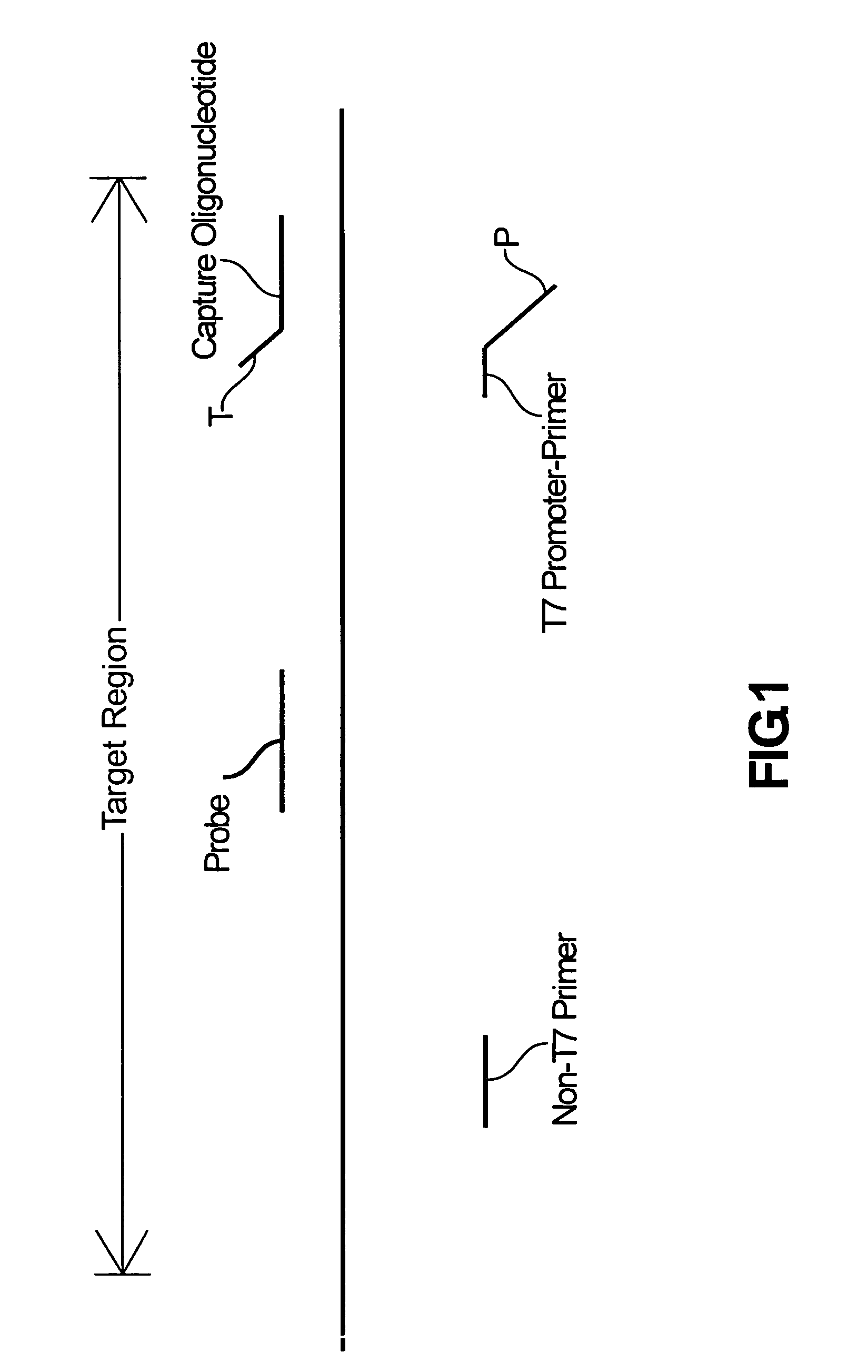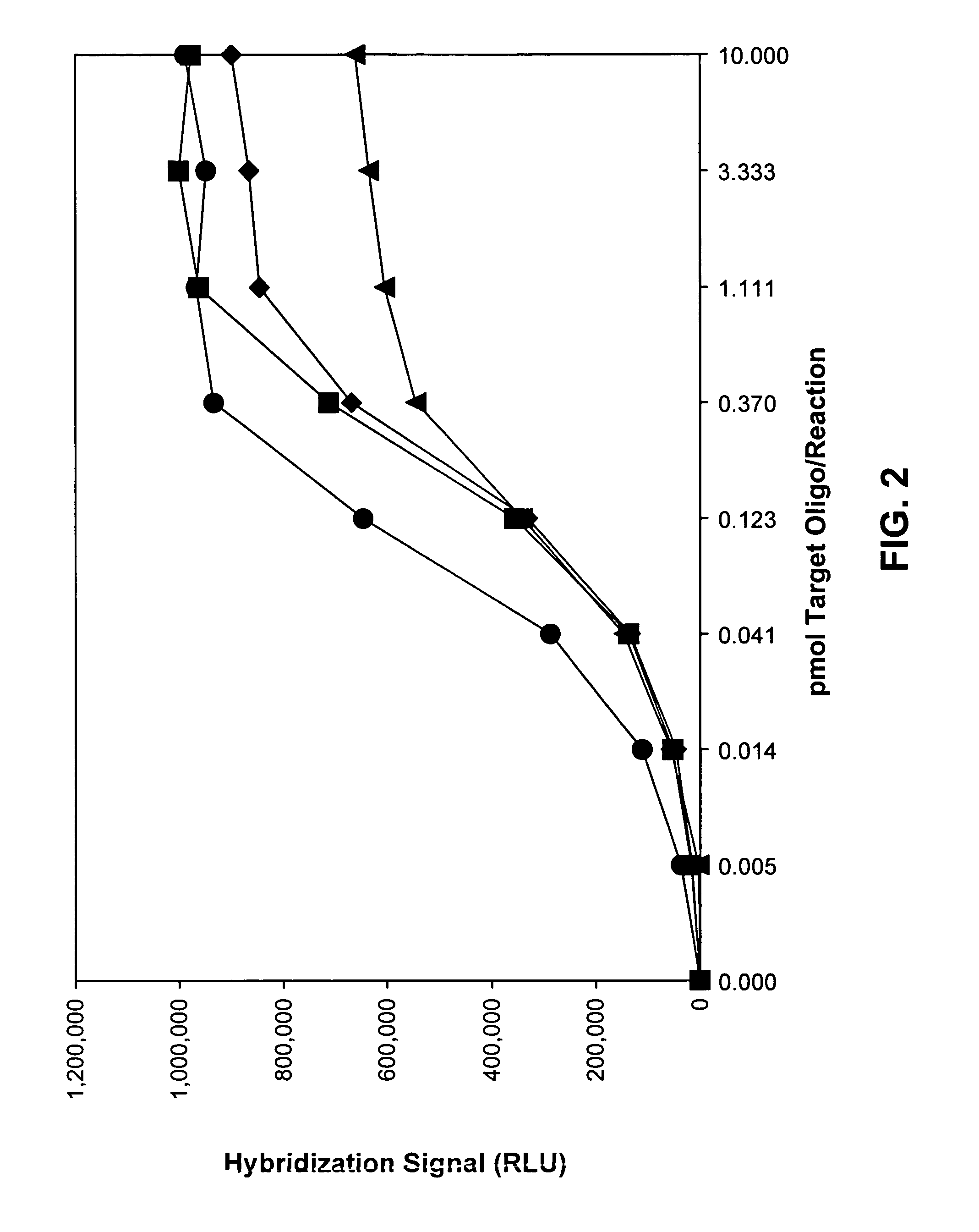Compositions and methods for detecting West Nile virus
- Summary
- Abstract
- Description
- Claims
- Application Information
AI Technical Summary
Benefits of technology
Problems solved by technology
Method used
Image
Examples
example 1
Oligonucleotide Probes for Detecting WNV
[0108]Synthetic WNV target oligonucleotides having the sequences presented in Table 9 were prepared according to standard laboratory procedures using 2′-OMe nucleotide analogs to mimic an RNA structure. Probes for hybridizing these synthetic WNV targets had the sequences given in Table 7, and were also prepared using 2′-OMe nucleotide analogs.
[0109]
TABLE 9Synthetic Target SequencesTargetTarget SequenceSEQ ID NO:5′ Non-CodingGCCCUCCUGGUUUCUUAGACAUCSEQ ID NO:143RegionUUGCCGGGCCCUCCUGGUUUCUUASEQ ID NO:144GACAUCCGCGUUUUAGCAUAUUGACAGCCCSEQ ID NO:1453000 RegionUCCACCUCUUGCGAAGGACCUCCSEQ ID NO:1463′ Non-CodingGUCGCAGGCAGCACCGUCUACUCASEQ ID NO:147RegionACCAGUCCUCCUGGGGUUGAGUCGCASEQ ID NO:148GAGACGGUUCUGAGGGCUUACAUSEQ ID NO:149CAGUCCCCCUGGGGUUGAGUCGCASEQ ID NO:150CAGUCCUCCUGGGGUUGAGCCGCASEQ ID NO:151CAGUCAUCCUGGGGUUGAGUCGCASEQ ID NO:152
[0110]Hybridization reactions included about 1×106 RLUs of AE-labeled probe having a specific activity of about 2×108 ...
example 2
Identification of Amplification Primers
[0121]A viral lysate served as the source of WNV template sequences in amplification reactions that employed paired sets of primers. TMA reactions were carried out essentially as described by Kacian et al., in U.S. Pat. No. 5,399,491, the disclosure of this U.S. patent having been incorporated by reference hereinabove. Each promoter-primer included a T7 promoter sequence AATTTAATACGACTCACTATAGGGAGA (SEQ ID NO:153) upstream of a WNV-complementary sequence. Amplification reactions were conducted for various primer combinations using either 5 μl or 1.4 μl of a 1:10,000 dilution of a viral lysate of the NY99 WNV strain as a source of the WNV template (each reaction contained less than 1 PFU viral equivalents), and 10 pmoles of each primer in 100 μl of reaction buffer. The viral lysate was obtained from the Centers for Disease Control, National Center for Infectious Disease, Division of Vector-Borne Infectious Disease, Fort Collins, Colo. Nucleic ac...
example 3
Identification of Amplification Primers
[0128]Amplification reactions employing paired sets of primers specific for the 3000 region of WNV were carried out essentially as described under Example 2, except that promoter-primers having the WNV-complementary sequences presented in Table 4 were used in combination with opposite strand primers having the sequences presented in Table 3. Amplification reactions were conducted for the various primer combinations using 5 μl or 1.4 μl of a 1:10,000 dilution of the above-described viral lysate (each reaction contained less than 1 PFU viral equivalents). Nucleic acids underwent specimen processing in accordance with Example 2, using combinations of capture oligonucleotides that included the target-complementary sequences of SEQ ID NO:117, SEQ ID NO:118 and SEQ ID NO:119 or the target-complementary sequences of SEQ ID NO:120, SEQ ID NO:126, and SEQ ID NO:130. Each capture oligonucleotide was used at a level of 2–5 pmoles / reaction in the target ca...
PUM
| Property | Measurement | Unit |
|---|---|---|
| Volume | aaaaa | aaaaa |
| Volume | aaaaa | aaaaa |
| Volume | aaaaa | aaaaa |
Abstract
Description
Claims
Application Information
 Login to View More
Login to View More - R&D
- Intellectual Property
- Life Sciences
- Materials
- Tech Scout
- Unparalleled Data Quality
- Higher Quality Content
- 60% Fewer Hallucinations
Browse by: Latest US Patents, China's latest patents, Technical Efficacy Thesaurus, Application Domain, Technology Topic, Popular Technical Reports.
© 2025 PatSnap. All rights reserved.Legal|Privacy policy|Modern Slavery Act Transparency Statement|Sitemap|About US| Contact US: help@patsnap.com



